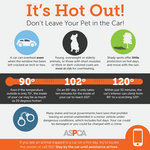




With another week of searing temperatures and heat indices at or above around 100 degrees, pet owners are being reminded that keeping pets cool will ensure a long and healthy relationship with your animal friends.
Kimberly Harman, animal services director at the Chatham County Animal Shelter, notes that the shelter takes great lengths to keep animals awaiting adoption cool. In the dog kennels, there are HVAC units that keep the air at a constant 80 degrees in the summer. But the Animal Shelter does more.
“One of the fun things our volunteers and staff do is they bathe them and have fun water play,” Harman said. “That’s enrichment and it cools them down.”
It’s important for pet owners to know the basics of keeping pets cool and to recognize dangers before they reach a point of damaging your pets’ health.
Don’t leave your pet in the car
According to The Humane Society, temperatures in a car on an 85 degree day can reach 102 degrees within 10 minutes — even with the windows cracked — and up to 120 degrees after 30 minutes. Both the Humane Society and the American Society for the Prevention of Cruelty to Animals (ASPCA) urge pet owners to never leave a pet in the car, even for a short period of time, even with the car running and the air conditioner on.
“Your pet may suffer irreversible organ damage or die,” the Humane Society website reads.
If you see an animal left inside a car, the Chatham County Sheriff’s Office wants concerned residents to call 911 and an animal resource officer will respond. The animal will not only be rescued, but the department will then make efforts to locate the animal’s owner.
“Our intent is for education and prevention for the best interests of animals and people,” Sheriff Mike Roberson said.
It’s not just the heat, it’s the humidity.
“It’s important to remember that it’s not just the ambient temperature but also the humidity that can affect your pet,” says Dr. Barry Kellogg of the Humane Society Veterinary Medical Association. “Animals pant to evaporate moisture from their lungs, which takes heat away from their body. If the humidity is too high, they are unable to cool themselves, and their temperature will skyrocket to dangerous levels—very quickly.”
Keep your pets cool
When it’s hot outside, pets can dehydrate quickly, so always make sure they have plenty of fresh, clean water. When it’s very hot, add ice cubes to their water to keep it cool. When outside, pets should have a shady place to get out of the sun where there is plenty of air flow. A dog house offers little respite from the heat. When it’s extremely hot, it’s best to keep your pets indoors.
Some dogs love water, but not all dogs are good swimmers. Dogs bellies have the thinnest skin so letting them rest in shallow water will provide an opportunity to cool their body temperature. Don’t leave your pets unsupervised around a pool and make sure they wear flotation devices when on boats. It is also a good idea to rinse your dog off after swimming to remove chlorine or salt from his fur and try to keep your dog from drinking pool water. You can also trim longer hair on your dog, but should never shave them as their fur can protect them from overheating and sunburn. Brushing cats more often than usual can prevent problems caused by excessive heat.
Pets can suffer overheating or heat stroke.
Care should be taken when exercising your pet when the temperature and humidity rise. On hot days, limit exercise to early morning and evening hours. If you place your hand on asphalt and it’s hot, your pet’s paws may burn, so walk them on the grass if possible. Animal advocates also ask owners to pay special attention to pets with white-colored ears, which are more susceptible to skin cancer, and short-nosed pets, like Pugs and Persian cats, are more susceptible to overheating and heat stroke since they cannot pant as effectively. And owners should always take water with them to help their pet from dehydrating.
Signs of heatstroke
Symptoms of overheating and heatstroke in pets include excessive panting or difficulty breathing, increased heart and respiratory rate, glazed eyes, drooling, excessive thirst, mild weakness, lack of coordination, or even seizures and unconsciousness. If you suspect your pet is suffering heatstroke, move them into the shade or an air-conditioned area and apply ice packs or cold towels to their head, neck and chest or run cool (not cold) water over them. Let them drink small amounts of cool water or lick ice cubes and take them to a veterinarian.
Reporter Casey Mann can be reached at CaseyMann@Chathamnr.com.